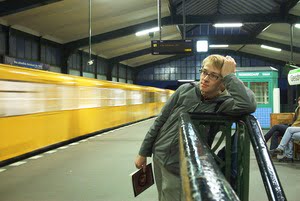For 29 years between the abrupt construction of the Berlin Wall in 1961 and its dramatic fall in 1989, the city existed as a divided urban entity. Because cities do not grow their infrastructures expecting to be artificially divided, Berlin’s early 20th century development was partially undone by the precipitous divorce (not to mention WWI bombing). When we imagine the sharp human turmoil endured by Berlin residents during the Wall’s tenure, we think of the many human stories – families torn apart, escape attempts that ended tragically, and divergent economic paths that led to strikingly different qualities of life.
But the Wall’s erection not only challenged Berlin politically, economically, and socially; it posed unusual problems for the once-unified infrastructure. Imagine dividing an American city into two completely different countries today. Consider the impact a hostile separation would have on utilities, transit, and other infrastructure concerns. For example, how would Chicago’s El Trains function if a giant barrier were built in the middle of the Loop dividing North from South? This is the kind of problem Berlin’s U-Bahn (subway) and S-Bahn (light rail) experienced when East Germans authorities constructed the Wall.
Transit History: Before WWII
Berlin grew rapidly from the late 1800s to the WWII era, and in 1920, it swallowed up surrounding suburbs to become Gross-Berlin (Greater Berlin). Like many expanding cities during this time, Berlin employed a combination of rail options to reduce traffic congestion. Planning for the U-Bahn began in the 1890s, with the first line opening in 1902. The S-Bahn began operating in 1924 when previously existing above-ground trains were converted from steam power into transit-friendlier electric rail. Packing the double-punch of this integrated transit network, Berlin was poised to provide models for other large cities, especially as it hosted the 1936 Olympics. Before WWII, Berlin boasted a population of well over 4 million – an apex to which it has not yet returned.
1945 – 1961: Post War, Pre-Wall
Bombing from WWII, and the subsequent fires and floods, destroyed significant parts of Berlin’s U-Bahn and S-Bahn transit systems. After the war, when the city was jointly occupied by Allied forces (French, American, British, and Soviet), the damaged parts of the U-Bahn and S-Bahn were slowly rehabilitated to basic functionality. With the increasingly frosty relationship between the Soviet-led sector and the Western sectors, however, Berlin’s public transit faced obstacles in day-to-day use, although people from all sectors were allowed to move somewhat freely between zones. But as “East Germany” emerged as a communist, separatist entity, some S-Bahn trains originating in East Berlin refused to stop at stations in the West Berlin enclave, powering their way through the Allied sectors to reach the East German territory outside of Berlin. Customs checks initiated by the East Germans and other trapping of political division began to impede the system’s efficiency.
1961 – 1989: The Wall Years
When the Berlin Wall appeared in 1961, the transit system, which was functional but burdened, would face even more complex operational challenges. The East Germans under Soviet tutelage conceived the Wall, which they called antifaschistischer Schutzwall or “anti-fascist protection wall,” to prevent further emigration to the West (especially by scientists and other intellectuals). Once it became clear that Berlin would remain a divided city well into the future, planners had to deal with S-Bahn and U-Bahn lines that has been cut off or which traveled through “enemy” territory.
The U2 line is the prime instance of a fragmented U-Bahn corridor. It was used by West Berliners until it reached Wittenbergplatz, its new easternmost terminal in West Berlin. East Berliners used their side of the U2 from Thalmannplatz eastward to the rest of the communist city. A stretch of track between the Western-controlled Wittenbergplatz and the Eastern-controlled Thalmannplatz lay dormant, with four stations no longer in use for the U2 line. Two of the four stations, Nottendorfplatz and Gleisdreleck, were used by other U-Bahn lines in West Berlin. Of the remaining two, one was completely abandoned in West German territory (Burlowstrasse) while the other faced a similar fate in East German territory (Potsdammerplatz).
But these two unused U-Bahn stations were not the true Geisterbahnhöfe or “ghost stations.” That label was reserved for an even more bizarre circumstance involving the U6 and U8 lines, both of which started and ended in West Berlin territory but passed through East Berlin. East German authorities permitted these otherwise Western trains to move through corridors in communist territory; however, all the East Berlin stations were sealed off and those stops were eliminated. To tighten security, the tunnels were narrowed and the trains were required to slow down significantly. As West Germans looked from their subway cars, they saw the eerie sight of closed platforms, dimly lit and patrolled only by armed police. Imagine traveling through hostile territory in a subway car for your daily commute.
The U8 line had six of these ghost stations in East Berlin. Five were totally shut down: Bernauerstrasse, Rosenthalerplatz, Weinmeisterstrase, Jannowitzbrücke, and Heinrich-Heine-Strasse. A sixth station, Alexanderplatz, was partially a ghost station – where access remained blocked for the Western U8 line while East Germans continued to board their S-Bahn, U5, and U2 lines there.
Riders on the Western U6 line passed through five ghost stations, four of which were entirely closed: Schwartzkopffstrasse, Nordbahnhof (now Zinnowitzerstrasse), Oranienburger, and Französischestrasse. The fifth U6 ghost station was Stadtmitte, which still functioned for the East German U2 line. Many East Berliners were entirely unaware of the U-Bahn ghost stations, since the communist regime did not want to create interest in Western trains passing through their territory. Often, unbeknownst to oppressed East Berlin residents, trains carrying their free counterparts were just on the other side of a wall at stations like Stadtmitte and Alexanderplatz.
S-Bahn trains operating after the Wall was constructed also passed through ghost stations. The Nord-Sud Bahn, for example, began and ended in West Berlin but traversed five East Berlin stations without stopping. Several of the U-Bahn ghost stations were also S-Bahn ghost stations on the Nord-Sud Bahn, including Nordbahnhof and Potsdammerplatz.
The entire S-bahn system was actually operated by the East German government (until 1984), even though much of it ran through West Berlin. To show their disapproval for the Wall, many West Berliners boycotted the S-Bahn on their side, which resulted in delapidated stations that became havens for crime. West Berlin residents were reluctant to pay fares to what was essentially the East German government, so they created bus routes that ran along similar paths. Because stations were neglected and routes were underused, most S-Bahn line service was dropped by the East Germans, not to be resumed until reunification. The scenario was truly strange. After all, reluctant West German S-Bahn employees were often working for the East German government!
One final transit anomaly of the Berlin Wall years was the Friedrichstrasse station. Located within East Berlin but serving as a transfer point between S-Bahn and U-Bahn lines, this was the one station in communist territory where West Berliners were allowed to disembark trains. Treated like passengers on a layover at an international airport, West Berliners were able to linger briefly within the confines of the station before making their connection and heading back into their part of Berlin. Friedrichstrasse received this special status because it was the transfer point between the Western U6 line (discussed above) and several Western S-Bahn trains. Although the station also served East German transit lines, there was a barrier separating the two sides, making them two distinct stations. Only a strict border control facility, much like Checkpoint Charlie, allowed travel between the East German and West German parts of the station.
Re-tracking History: Transit After Reunification
Both sides expanded their half of the U-Bahn system during the Wall years, resulting in curious, incongruent growth of lines. West Berliners built some entirely new lines within their exclusive territory, including U9. Once Germany was reunified, transit officials had to piece the two systems back together, even though they had evolved separately for nearly 30 years.
A number of the ghost stations have been brought back to life, including Potsdammerplatz. Abandoned stations on the U2 were also reopened, making the line complete again. Walls came down at Alexanderplatz and Stadtmitte to reveal trains from the other side, a surprise for some East Berliners in particular. Once-derelict S-bahn stations in the former West Berlin were revamped. The costly task of reintegrating divergent infrastructures occupied transit planners for much of the 1990s.
Today, the U-bahn system features 9 lines, while the S-bahn system features 17 lines. Working in concert under a single-fare structure, these intertwined systems are the transit arteries of the new Berlin, but the legacy of the city’s unusual past will always linger.




